
Alsace is a cultural region and a territorial collectivity in eastern France, on the west bank of the upper Rhine next to Germany and Switzerland. In January 2021, it had a population of 1,919,745. Alsatian culture is characterized by a blend of German and French influences.
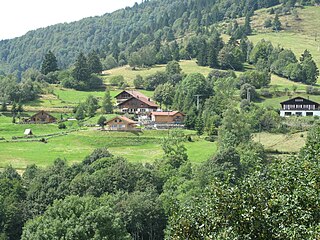
The Vosges are a range of medium mountains in Eastern France, near its border with Germany. Together with the Palatine Forest to the north on the German side of the border, they form a single geomorphological unit and low mountain range of around 8,000 km2 (3,100 sq mi) in area. It runs in a north-northeast direction from the Burgundian Gate to the Börrstadt Basin, and forms the western boundary of the Upper Rhine Plain.

Three European Union schemes of geographical indications and traditional specialties, known as protected designation of origin (PDO), protected geographical indication (PGI), and traditional speciality guaranteed (TSG), promote and protect names of agricultural products and foodstuffs, wines and spirits. Products registered under one of the three schemes may be marked with the logo for that scheme to help identify those products. The schemes are based on the legal framework provided by the EU Regulation No 1151/2012 of the European Parliament and of the Council of 21 November 2012 on quality schemes for agricultural products and foodstuffs. This regulation applies within the EU as well as in Northern Ireland. Protection of the registered products is gradually expanded internationally via bilateral agreements between the EU and non-EU countries. It ensures that only products genuinely originating in that region are allowed to be identified as such in commerce. The legislation first came into force in 1992. The purpose of the law is to protect the reputation of the regional foods, promote rural and agricultural activity, help producers obtain a premium price for their authentic products, and eliminate the unfair competition and misleading of consumers by non-genuine products, which may be of inferior quality or of a different flavour. Critics argue that many of the names, sought for protection by the EU, have become commonplace in trade and should not be protected.

Munster, Munster-géromé, or (Alsatian) Minschterkaas, is a soft cheese with a strong taste and aroma, made mainly from milk first produced in the Vosges, between the Alsace-Lorraine and Franche-Comté regions in France. The name "Munster" is derived from the Alsace town of Munster, where, among Vosgian abbeys and monasteries, the cheese was conserved and matured in monks' cellars.
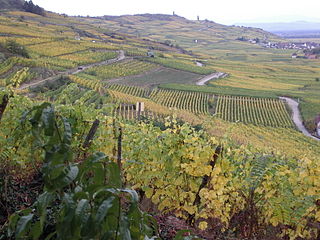
Alsace wine or Alsatian wine is produced in the Alsace region in France and is primarily white wine. Because of its Germanic influence, it is the only Appellation d'Origine Contrôlée region in France to produce mostly varietal wines, typically from similar grape varieties to those used in German wine. Along with Austria and Germany, it produces some of the most noted dry Rieslings in the world as well as highly aromatic Gewürztraminer wines. Wines are produced under three different AOCs: Alsace AOC for white, rosé and red wines, Alsace Grand Cru AOC for white wines from certain classified vineyards and Crémant d'Alsace AOC for sparkling wines. Both dry and sweet white wines are produced.

Burrata is an Italian cow's milk cheese made from mozzarella and cream. The outer casing is solid cheese, while the inside contains stracciatella and clotted cream, giving it an unusual, soft texture. It is a speciality of the Puglia region of southern Italy.
Table wine is a wine term with two different meanings: a style of wine and a quality level within wine classification.
The European Institute of Innovation and Technology (EIT) is an independent body of the European Union with juridical personality, established in 2008 intended to strengthen Europe's ability to innovate. The EIT’s three “core pillars” of activities are: entrepreneurial education programmes and courses across Europe that transform students into entrepreneurs; business creation and acceleration services that scale ideas and budding businesses; and innovation-driven research projects that turn ideas into products by connecting partners, investors, and expertise.
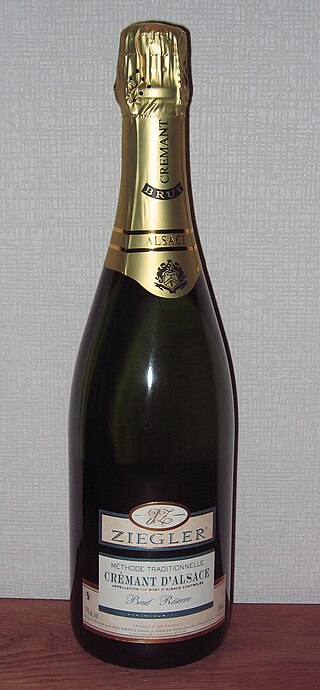
Crémant d'Alsace is an Appellation d'Origine Contrôlée for sparkling wines made in the Alsace wine region of France. Produced since 1900, the Crémant d'Alsace AOC was recognized in 1976 by the INAO and the designation Crémant regulated by the European Parliament in 1996.
A Community design is a unitary industrial design right that covers the European Union. It has both unregistered and registered forms. The unregistered Community design (UCD) came into effect on 6 March 2002 and the registered Community design (RCD) was available from 1 April 2003.
The Trade Control and Expert System (TRACES), is a web-based veterinarian certification tool used by the European Union for controlling the import and export of live animals and animal products within and without its borders. Its network falls under the responsibility of the European Commission. TRACES constitutes a key element of how the European Union facilitates trade and improves health protection for the consumer, as laid down in the First Pillar principle. Other countries use computer networks to provide veterinary certification, but TRACES is the only supranational network working at a continental scale of 28 countries and almost 500 million people.

The wine region of Alsace produces wines under three different Appellations d'Origine Contrôlées (AOCs): Alsace AOC for white, rosé and red wines, Alsace Grand Cru AOC for white wines from certain classified vineyards and Crémant d'Alsace AOC for sparkling wines. This region is the only French wine region allowed to label its wines based on variety.
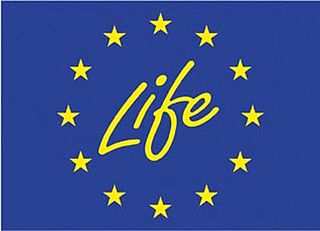
The LIFE programme is the European Union's funding instrument for the environment and climate action. The general objective of LIFE is to contribute to the implementation, updating and development of EU environmental and climate policy and legislation by co-financing projects with European added value. LIFE began in 1992 and to date there have been five phases of the programme. During this period, LIFE has co-financed some 4600 projects across the EU, with a total contribution of approximately 6.5 billion Euros to the protection of the environment and of climate. For the next phase of the programme (2021–2027) the European Commission proposed to raise the budget to 5.45 billion Euro.
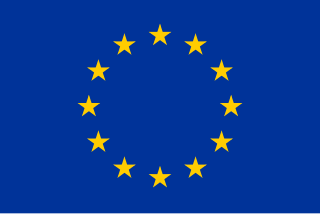
The Marine Strategy Framework Directive is a European Directive aimed at achieving or maintaining Good Environmental Status (GES) in European seas by the year 2020.
Organic fulfilment is a form of order fulfillment widely recognized in the EU where the distribution center or warehouse holds organic certification to stores and despatched Organic products. The distribution centre or fulfilment house uses a range of comprehensive record keeping to show inventory figures, traceability of stock and of cleaning and hygiene measures to ensure organic standards of the certifying body are met. Standards for organic food are laid down by the European Union.
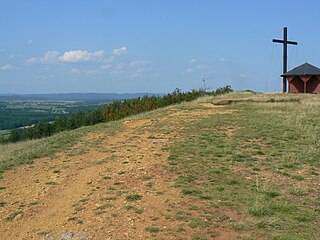
The Bastberg, also called Petit-Bastberg, is a summit located near the Northern Vosges Regional Nature Park, in the commune of Bouxwiller. It culminates at 326 meters. The ecosystem is fragile due to human and natural intrusions, and has been the subject of conservation measures since 1989.

The flora of the Vosges massif is distributed across three principal altitudinal zones, namely the collinean, montane, and subalpine levels. The collinean zone extends up to approximately 500 meters in altitude. The montane zone is between 500 and 1,000 meters, with the subalpine zone extending beyond that. The latter's highest point is the Grand Ballon, which reaches 1,424 meters. The diverse environmental conditions, including altitude, climate, topography, and soil types, contribute to the formation of heterogeneous vegetation. The north-south orientation of the mountain range results in a marked contrast between the eastern and western slopes. The western slopes receive abundant precipitation from westerly winds, while the eastern slopes and peaks experience drier conditions.
Alsace Grand Cru ‘’Engelberg’’ is a French white wine produced in the Bas-Rhin department, in Alsace.













